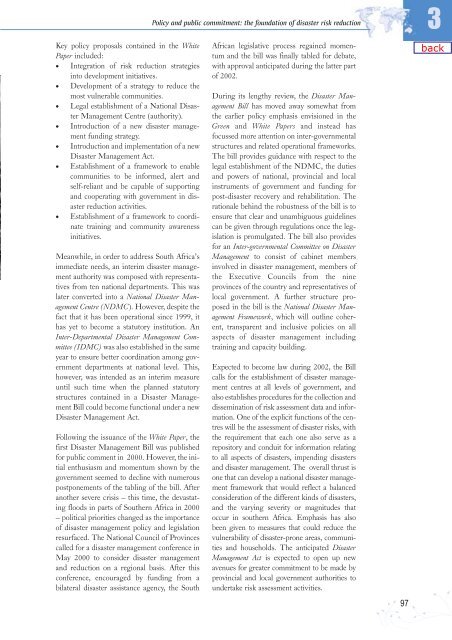Living with Risk. A global review of disaster reduction initiatives
Living with Risk. A global review of disaster reduction initiatives
Living with Risk. A global review of disaster reduction initiatives
You also want an ePaper? Increase the reach of your titles
YUMPU automatically turns print PDFs into web optimized ePapers that Google loves.
Key policy proposals contained in the White<br />
Paper included:<br />
• Integration <strong>of</strong> risk <strong>reduction</strong> strategies<br />
into development <strong>initiatives</strong>.<br />
• Development <strong>of</strong> a strategy to reduce the<br />
most vulnerable communities.<br />
• Legal establishment <strong>of</strong> a National Disaster<br />
Management Centre (authority).<br />
• Introduction <strong>of</strong> a new <strong>disaster</strong> management<br />
funding strategy.<br />
• Introduction and implementation <strong>of</strong> a new<br />
Disaster Management Act.<br />
• Establishment <strong>of</strong> a framework to enable<br />
communities to be informed, alert and<br />
self-reliant and be capable <strong>of</strong> supporting<br />
and cooperating <strong>with</strong> government in <strong>disaster</strong><br />
<strong>reduction</strong> activities.<br />
• Establishment <strong>of</strong> a framework to coordinate<br />
training and community awareness<br />
<strong>initiatives</strong>.<br />
Meanwhile, in order to address South Africa’s<br />
immediate needs, an interim <strong>disaster</strong> management<br />
authority was composed <strong>with</strong> representatives<br />
from ten national departments. This was<br />
later converted into a National Disaster Management<br />
Centre (NDMC). However, despite the<br />
fact that it has been operational since 1999, it<br />
has yet to become a statutory institution. An<br />
Inter-Departmental Disaster Management Committee<br />
(IDMC) was also established in the same<br />
year to ensure better coordination among government<br />
departments at national level. This,<br />
however, was intended as an interim measure<br />
until such time when the planned statutory<br />
structures contained in a Disaster Management<br />
Bill could become functional under a new<br />
Disaster Management Act.<br />
Following the issuance <strong>of</strong> the White Paper, the<br />
first Disaster Management Bill was published<br />
for public comment in 2000. However, the initial<br />
enthusiasm and momentum shown by the<br />
government seemed to decline <strong>with</strong> numerous<br />
postponements <strong>of</strong> the tabling <strong>of</strong> the bill. After<br />
another severe crisis – this time, the devastating<br />
floods in parts <strong>of</strong> Southern Africa in 2000<br />
– political priorities changed as the importance<br />
<strong>of</strong> <strong>disaster</strong> management policy and legislation<br />
resurfaced. The National Council <strong>of</strong> Provinces<br />
called for a <strong>disaster</strong> management conference in<br />
May 2000 to consider <strong>disaster</strong> management<br />
and <strong>reduction</strong> on a regional basis. After this<br />
conference, encouraged by funding from a<br />
bilateral <strong>disaster</strong> assistance agency, the South<br />
Policy and public commitment: the foundation <strong>of</strong> <strong>disaster</strong> risk <strong>reduction</strong><br />
African legislative process regained momentum<br />
and the bill was finally tabled for debate,<br />
<strong>with</strong> approval anticipated during the latter part<br />
<strong>of</strong> 2002.<br />
During its lengthy <strong>review</strong>, the Disaster Management<br />
Bill has moved away somewhat from<br />
the earlier policy emphasis envisioned in the<br />
Green and White Papers and instead has<br />
focussed more attention on inter-governmental<br />
structures and related operational frameworks.<br />
The bill provides guidance <strong>with</strong> respect to the<br />
legal establishment <strong>of</strong> the NDMC, the duties<br />
and powers <strong>of</strong> national, provincial and local<br />
instruments <strong>of</strong> government and funding for<br />
post-<strong>disaster</strong> recovery and rehabilitation. The<br />
rationale behind the robustness <strong>of</strong> the bill is to<br />
ensure that clear and unambiguous guidelines<br />
can be given through regulations once the legislation<br />
is promulgated. The bill also provides<br />
for an Inter-governmental Committee on Disaster<br />
Management to consist <strong>of</strong> cabinet members<br />
involved in <strong>disaster</strong> management, members <strong>of</strong><br />
the Executive Councils from the nine<br />
provinces <strong>of</strong> the country and representatives <strong>of</strong><br />
local government. A further structure proposed<br />
in the bill is the National Disaster Management<br />
Framework, which will outline coherent,<br />
transparent and inclusive policies on all<br />
aspects <strong>of</strong> <strong>disaster</strong> management including<br />
training and capacity building.<br />
Expected to become law during 2002, the Bill<br />
calls for the establishment <strong>of</strong> <strong>disaster</strong> management<br />
centres at all levels <strong>of</strong> government, and<br />
also establishes procedures for the collection and<br />
dissemination <strong>of</strong> risk assessment data and information.<br />
One <strong>of</strong> the explicit functions <strong>of</strong> the centres<br />
will be the assessment <strong>of</strong> <strong>disaster</strong> risks, <strong>with</strong><br />
the requirement that each one also serve as a<br />
repository and conduit for information relating<br />
to all aspects <strong>of</strong> <strong>disaster</strong>s, impending <strong>disaster</strong>s<br />
and <strong>disaster</strong> management. The overall thrust is<br />
one that can develop a national <strong>disaster</strong> management<br />
framework that would reflect a balanced<br />
consideration <strong>of</strong> the different kinds <strong>of</strong> <strong>disaster</strong>s,<br />
and the varying severity or magnitudes that<br />
occur in southern Africa. Emphasis has also<br />
been given to measures that could reduce the<br />
vulnerability <strong>of</strong> <strong>disaster</strong>-prone areas, communities<br />
and households. The anticipated Disaster<br />
Management Act is expected to open up new<br />
avenues for greater commitment to be made by<br />
provincial and local government authorities to<br />
undertake risk assessment activities.<br />
97<br />
3

















